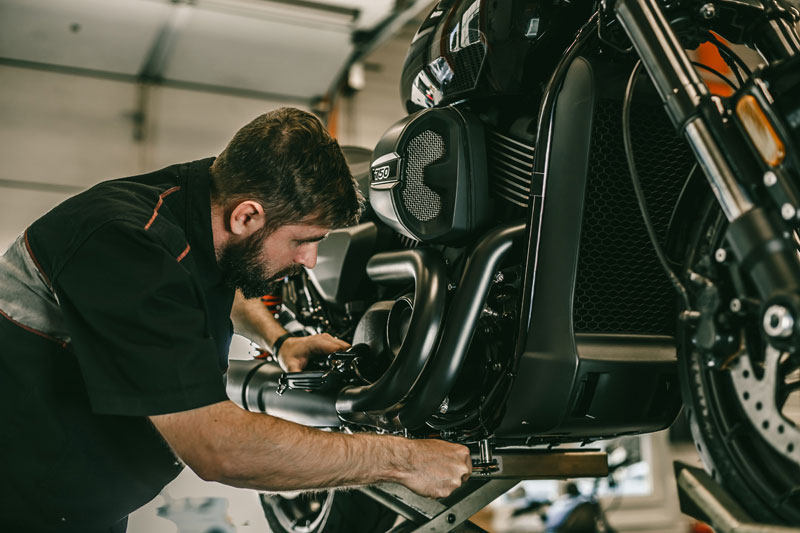
Important Maintenance Checks for Motorcycle Storage
From the fuel and lube to the battery and tires, learn how you can keep your bike from corroding during the cold season.

By: Eric Garbe Courtesy: Motorcycle Powersports News
It’s just so easy to roll it to the side of the garage, keep it out of the way, put a cover on it and forget about it until spring. The problem? It’s just not a good idea. I’m talking about a motorcycle. Whether it’s yours, a customers, or someone asking you about it, there are a number of important and critical aspects to motorcycle storage that shouldn’t be overlooked.
If you do, you might get away with it, especially if you have a short winter, but if you take no steps for storage, it will catch up with you. Maybe not right away, but it will.
Fuel Check
I always like to start with fuel storage. Fuel stabilizer is well-known, and one of the most common additives. Does it work? Yes. How? It slows down the normal chemical breakdown of gasoline (referred to scientifically as oxidation), and many stabilizers also contain rust inhibitors and some type of alcohol.
The alcohol in a fuel stabilizer will bind with any water or moisture, allowing it to be burned off in the engine. Rust and corrosion inhibitors need no explanation, and in addition to the tank, there are metal components in multiple locations of the fuel system that will benefit from this protection.
Even the smallest amount of moisture can do damage to the inside of a tank, carburetor or fuel injection components, and it can find its way into a fuel tank in many ways, including temperature swings and condensation, which can occur whether a motorcycle is stored in an outbuilding or in an attached garage.
So, when it comes to the fuel system, here’s the best plan:
- Fill the tank with fuel.
- Add fuel stabilizer per the recommendations on the brand you have and run the engine so the stabilizer is able to circulate into or through the entire fuel system.
- Shut off the fuel valve. If it’s equipped with carburetors, drain them. Even though there is stabilizer in the fuel, the amount in the float bowl is so minimal, it may still be susceptible to going bad. The corrosion inhibitors in the stabilizer will coat the internals and protect them, and draining the fuel will prevent any chance of degradation over time.
- When it’s time to start the bike in the spring, open the fuel valve and let fresh gas fill the float bowls.
Battery Check
Now comes the battery, and this one is simple. The best thing to do is connect a battery maintainer. Over time, any lead-acid battery will go dead. In some cases, it’s because of battery drain caused by electronic components and their memory, but even if there is none of this, a battery that sits will still go dead due to the chemical and electrical activity that occurs inside.
Electrical activity inside a battery is what keeps it from freezing. If a battery goes dead, it will freeze as quick as water (assuming it’s below 32 degrees F.) If the battery remains charged, it will not freeze. It’s important to use a battery charger and maintainer, as opposed to a standard charger. With a battery maintainer, once the battery is fully charged, it will only allow enough current flow to match the absorption rate of the battery, which prevents it from overcharging. Even a traditional “trickle charger” can overcharge a battery, be it at a slow rate, so a maintainer is best.
When focused on the battery, this is also a good time to check for corrosion or loose terminals and asses the age and condition. If the battery is getting old, you can plan on replacement before riding again.
Tire Check
Now, let’s look at the rolling stock, the tires. Inflate the tires to the proper pressure before storing to help prevent flat spots. Ideally, if you have a motorcycle stand and you can get the tires off the ground, this is the best option. As with the battery, this is a good time to look at the age and condition of the tires. If it’s time to replace them, better to plan on it now and put things in motion rather than wait until the spring rush when everyone wants to get things done.
Lube Check
Lubrication is the next thing on the list, and this includes everything from a grease fitting to chains to engine and transmission oil. Cleaning and lubricating the chain, for example, will flush away dirt and contaminants and prevent slow, continuous corrosion as the bike sits. It’s never bad to change engine oil, and you’re going to make the call depending on when it was done last. However, if it’s been a while or it is due, do you want to let old, contaminated, corrosive oil be that last thing that was circulated around and sit there all winter, or would you rather have everything on the inside coated with fresh, clean oil?
Finally, don’t forget the owner’s manual and the recommended service. The motorcycle manufacturer knows the most about the bike it built, and it will have a specific list of what it recommends, so you can tuck it away properly to wait for spring.
